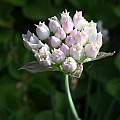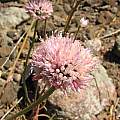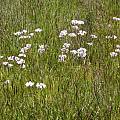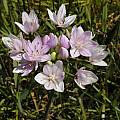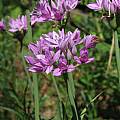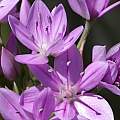On these pages photos of North American Allium species will be featured. There are approximately 130 taxa in North America, almost half of which occur in California as the center of diversity. Besides a few species that are widely grown, namely Allium cernuum (nodding onion), the Californian A. unifolium (popularized by the Dutch bulb trade) and the lesser known A. stellatum (prairie onion), the North American onion species have been largely ignored by the horticultural world. There are also about 15 species native to Mexico, similarly rare or absent from horticulture. Eastern American species generally need a cool - cold winter dormancy period with some to lots of rain. Western American species, especially those in the Pacific States follow a Mediterranean pattern where they need a moderately cold wet winter and a cool dry summer.
Taxonomically, there have been few changes in American species. A recent phylogenetic study by Nguyen et al, 2008 found that North American alliums are distinct from European species and those occurring in the California Floristic Province (CFP) are distinct from eastern American species. California holds a wide variety of species whose forms are distinctive in leaf morphology. Species related to Allium falcifolium form falcate leaves whereas species related to Allium jepsonii form a single leaf from which the inflorescence emerges on the side. Many CFP species have also adapted to a special type of soil called serpentine which is very high in minerals such as magnesium, making it toxic to many plants. Some Allium species are so adapted that they can only be found on serpentine soil in the wild.
American alliums G-Z are found on this wiki page. See American alliums A-F for the other American species.
Allium geyeri S.Watson is native to North American Pacific coast damp meadows. Named for the German botanist Charles A. Geyer who travelled across the Western USA in 1843. Height range: to about 50 cm. Photograph by Rimmer de Vries.
Allium glandulosum Link & Otto is a Mexican species that blooms in late summer and autumn with dark, metallic red flowers. Height: to about 30 cm. The plant shown here in the first three photos from Mark McDonough was originally collected in central Mexico at high elevation in swampy soil. It was difficult to photograph well. The first two show the true red flowers close up, the third an entire potted plant. The last photo by Wietse Mellema.
Allium gooddingii Ownbey - another of the moisture-loving western species, this one from Arizona and New Mexico, growing at high elevation swampy or marshy spots, or alongside streams. It's a slender plant, with a few-flowered upright spray of intense red-purple flowers. The gray stems reach about 18" (45 cm). In the photo we see the gray foliage of A. plummerae S.Watson in back and a flower head of A. flavum L. Photo by Mark McDonough.
Allium haematochiton S.Watson is found both on dry slopes and ridges from the south coast ranges of California into northern Baja, but also is found in seasonally moist, grassy meadows. It is tolerant of summer water and almost evergreen in those conditions. If dormant it is one of the first to appear in the fall and long blooming. It is also known to grow on serpentine. Height range: 15-40 cm. The first two photos were taken at Figueroa Mountain April 2005 by Mary Sue Ittner. The third photo was taken by Bob Rutemoeller. The last two pictures below are of bulbs grown and photographed by Nhu Nguyen. The second photo shows the blood-red skin of the bulbs, giving it the specific epithet "haematochiton" or "red tunic" in Greek, although not all forms will have the red color.
Allium hickmanii Eastw. is restricted to the central coast of California from the Monterey Peninsula to San Luis Obispo County. It is a relatively small onion with very thin leaves. It grows on grassy, wooded slopes. Height: to about 17 cm. The first two photos were taken by Nhu Nguyen at the UC Botanical Garden. The next two photos from Calflora were taken May 2022 by Irene Rosen in Monterey County and shared under a CC BY-NC license.
Allium howellii Eastw. is a mostly southern California species with three varieties. It has exserted stamens and prominent ovary crests. Height range: 1-2 ft.
Allium howellii var. clokeyi Ownbey & Aase ex Traub grows on open slopes in desert sagebrush scrub. It has white flowers, sometimes with pink midveins. Photos by Mary Sue Ittner of the flower and the bulb (shown on a 1 cm. square grid).
Allium howellii var. howellii is a common species with pale lavender flowers that grows on grassy slopes. It is distinguished from the other varieties by its thin stem.
Allium howellii var. sanbenitense (Traub) McNeal & T.D.Jacobsen grows on thinly grassy slopes in serpentine soils in San Benito and Fresno counties.
Allium hyalinum Curran is a California onion with small starry flowers that sparkle in bright sun. It is found in grasslands moist in the spring in the central and southern Sierra foothills. Height: to about 30 cm. There are generally two forms, a white and a pink. This species is easy in culture and multiples very well.
The photos below were taken by Nhu Nguyen on CA HW49 near Yosemite National Park. The plants were growing out of a thin organic mat on rocky surfaces where a seep occurs.
Below are photos of a white form. Photo 1 was taken by Bob Rutemoeller and photos 2-5 were taken by Nhu Nguyen at the Tilden Botanic Garden.
Photo 1-3 were taken by Nhu Nguyen of white and pink forms. Photo 4-5 from Mary Sue Ittner including the last showing the small bulbs on a 1 cm grid.
Allium jepsonii (Ownbey & Aase ex Traub) S.S.Denison & McNeal is a Californian species that grows in the Sierra Nevada foothills in two different areas, one on serpentine in the north and the other on volcanic soils in the central foothills. It has a single, terete, rat-tail-like leaf, from which pops out a flower stem from a basal incision near the base, and a small head of white, lightly nerved flowers in July. Needs excellent drainage. The stems tend to recline, as shown in the image. The species is often found on serpentine. For a while it was listed as an endangered species and has now been delisted due to discoveries of new populations. Height range: 20-40 cm. Photos by Mark McDonough, Mary Sue Ittner and Nhu Nguyen at the Tilden Botanic Garden.
Allium lacunosum S.Watson is a California species that occurs widely south of San Francisco. It has small white to pale pink flowers in close umbels. There are four varieties which are distinguished by measurement of plant parts and range. The photos below are of plants in cultivation. Height range: to about 35 cm. Photo 1 taken by Mary Sue Ittner is of an unknown variety. Photos 2-3 were taken by Nhu Nguyen of variety lacunosum.
Allium lacunosum var. lacunosum has leaves that are longer than the stem (10-20 cm). The flowers measure 7-9 mm. This variety is found along the coast and in the coast ranges. The photos below were taken by Nhu Nguyen from Ring Mountain where they occur on serpentine outcrops by the thousands. The petals fade to a rusty brown and are persistent as the seeds mature.
Allium lemmonii S.Watson has a rather broad range in the western states. It is found on slopes made of mostly clay soil, growing to about 20 cm tall. It is a relative of Allium falcifolium Hook. & Arn. where the leaves are flattened and somewhat falcate. Photo 1 shows the flower head, which is rather large, and photo 2 shows the habit. Photo 3 shows plants that are just starting to push up the buds. Photos by Nhu Nguyen taken at the Tilden Botanic Garden.
Allium mannii Traub & T.M.Howard - this is a Mexican species rare in cultivation. Surprisingly, many of the southwestern, Texan, and even Mexican onions are proving to be hardy in northern New England. This species is quite different than most other American onions, perhaps closed allied to A. plummerae S.Watson from Arizona and New Mexico. Allium mannii has spread slowly via short rhizomes, and reliably puts forth upfacing "rounded star-cup" flowers in open clusters for several weeks in July. As the fresh white flowers mature, the central ovaries age from pink to orangish-brown. Height range: 30-45 cm. Photo by Mark McDonough.
Allium membranaceum Ownbey ex Traub grows in Northern California from 500 to 4500 ft (150 to 1350 m) and is most similar to Allium campanulatum S.Watson than to any other species. It has white to pale pink flowers on an erect stem, flat leaves, and a very dainty appearance. Height range: 15-40 cm. Photos 1-3 were taken by Mary Sue Ittner. Photo 3 shows the bulbs on a 1 cm grid. Photos 3-6 were taken by Nhu Nguyen of the same clone.
Allium obtusum Lemmon is native to the Foothills and High Sierra Nevada and north to the Cascade Range of California and just a little bit of Nevada. It is a tiny species. Height range: 2-17 cm. The photos below were taken by Nhu Nguyen of plants growing in a 4" terracotta pot. Notice the pumice particles for scale.
Allium parryi S.Watson (syn. Allium fimbriatum var. parryi (S.Watson)Traub & Ownbey), grows on sandy or clay soils in the southern Sierra Nevada and southern California mountains, south to northern Baja California. It is white with pink midveins, fading to red as it ages. It has smooth ovary crests. Height: 20 cm. Photo taken in San Diego County by Jim Duggan.
Allium parvum Kellogg is known as the small or dwarf onion, as it rarely grows taller than five inches. The inflorescence is borne on a short scape close to the ground, with less than 30 pointed pinkish florets with dark mid veins and yellow pollen. The leaves are keeled, somewhat sickle shaped, growing longer than the scape. It is native to western North America from northern California, north to Oregon, east to Nevada and possibly Utah. It has also been reported to be found in the two most southwestern counties of Montana. It can be found growing in rocky clay soils, talus, from mid to high elevations. It is one of the species to inhabit the plateaus of Table Rocks in Jackson County, Oregon. Photos below by Travis Owen from Upper Table Rock in Oregon in March of 2015.
Allium peninsulare Lemmon ex Greene is a species from California, southern Oregon and Baja California with wine-red to dark rose-purple flowers in a loose umbel. Height: to about 20 cm. Photos 1-2 were taken by Mary Sue Ittner. Photo 3 was from San Diego County taken by Jim Duggan. Photos 4-5 were taken by Nhu Nguyen of some bulbs growing in a 4" terracotta pot. This species does not need a lot of room to do well.
Allium perdulce S.V.Fraser - a gem of a species, from the American plains and prairies, and extending southwards into Texas. The flowers are intensely fragrant like cloves (dianthus), so sweet and spicy that it'll force you onto your belly to take frequent whiffs. It's one of the earliest blooming species, with rich pink, flared urn-shaped flowers on mere 4"-6" (10-15 cm) stems. It's exceedingly slow to increase for me (usually goes the other way!) and never sets viable seed in my garden. To be coveted. Photos by Mark McDonough and a line drawing as well.
Allium platycaule S.Watson is a western American allium from California, Oregon & Nevada. It occurs on rocky or sandy slopes. The foliage is broad, gray, and sickle-shaped and arching sideways (falcate), and the large fuzzy globes of pink flowers only a few inches (15 cm) above the ground create a memorable sight. In the first photo, two bloom heads of the darker red-purple Allium falcifolium Hook. & Arn. can be seen. The first two photos were taken by Mark McDonough and the last photo by Nhu Nguyen was taken at the UC Botanical Garden.
Photos taken in Plumas County, California by Mary Sue Ittner.
Allium plummerae S.Watson has a very limited range in Arizona and New Mexico, where it is found at high elevations in marshes and alongside streams. Accordingly, it prefers good garden soil and adequate irrigation. It has upright tufts of strongly keeled (almost three-sided) grayish foliage and showy flat clusters of wide-open upright starry pure white flowers with creamy yellow ovaries that age a tawny orangish color. It is a very reliable, non-invasive, clump-forming species, blooming in July-August. Height: about to 60 cm. Photo by Mark McDonough who considers it to be one of his absolute favorite onions.
Allium praecox Brandegee is found in shaded grassy slopes in southwestern California. There are up to 40 purple-veined pale pink flowers, each on a long pedicel. Height range: 1-2 ft. This species has a common name of early onion as it flowers from March to May. Photos by Mary Sue Ittner
Allium sanbornii Alph.Wood is a large onion restricted to the Sierra Nevada and southern Cascade foothills of California. It is only found on serpentine outcrops. Photos by Nhu Nguyen. Seeds sprout readily and this species is actually one of the easier California onions to grow. It is one of the latest blooming species (around July) when most other native bulbs have already gone into dormancy. It requires a very dry summer dormancy period. Height range: to about 60 cm. The photos below were taken by Nhu Nguyen. Photos 1-3 were of plants growing at the Tilden Botanic Garden.
The photos below were taken by Nhu Nguyen of a white form of this species.
Allium serra McNeal & Ownbey is from the central coast ranges of California, found in grassy slopes, often under blue oaks (Quercus douglasii Hook. & Arn.), blooming from March to May. It has pink flowers which become more papery as they age. Photo 1 from Mary Sue Ittner shows an inflorescence blooming April 2005 in Bear Valley in Colusa County, California. Height: to about 40 cm. Photos 2-5 from Nhu Nguyen show plants in habitat near Mt. Hamilton, Santa Clara County, California.
The photos below are of plants in cultivation. Photo 1 was taken by Mary Sue Ittner. Photos 2-3 were taken by Nhu Nguyen. Photo 3 shows the bulb scale's beautiful "herring bone" pattern. This character is very important in identifying this and several other related species.
Allium sharsmithiae (Ownbey & Aase ex Traub)McNeal is a small onion restricted to the Mt. Hamilton Range in central California. It occurs only on serpentine soil. The leaves will often die down before the flowers bloom. Height: to about 25 cm. Photos by Nhu Nguyen taken in habitat. The last photo shows a typical talus slope habitat for this species. Look to the lower right hand corner and you can make out pink patches that are these plants.
Allium shevockii McNeal is also another small but beautiful onion with a large inflorescence of dark red petals. It is found only on Spanish Needle Peak area in Kern County, California where it grows on metamorphic outcrops or talus. It was first collected by Jim Shevock, for whom the species was named. Height: to about 40 cm. Photos by Nhu Nguyen at the Tilden Botanic Garden. The last photo shows the glaucous and thick succulent leaves and buds.
Allium sp. Seeds of this undetermined species was collected in Chiapas, Mexico. It is a nice little plant that grows and blooms well in a 10 cm (4 inch) pot. It is a summer grower and needs a dry winter dormancy. It takes 3 years to flower this plant from seeds.
Allium stellatum Ker-Gawler is distributed from central Canada through the central part of the United States. It is commonly known as "prairie onion". It blooms from August into October with 2 to 3 inch (5-7.6 cm) heads of whitish to lavender florets. It is native to rocky soils and grows in clumps of narrow tubular foliage 30 to 70 cm (1 to 2 feet) tall. Photo from Steve Evans of plant flowering in Oklahoma September 2018. He notes that he has never seen it much more than about 1 foot (30 cm) tall.
Allium texanum T.M.Howard - a species from... you guessed it, Texas. First described and published in 1990 by Thad Howard, one of several species emerging from the overgeneralized muddle of Marion Ownbey's Allium canadense var. fraseri. Hardy here in New England, with gray twisting foliage, and attractive white flowers in late June through July. Height: about 35 cm. Photo by Mark McDonough.
Allium tolmiei Baker at the Lawrence Grassland Preserve (Nature Conservancy) near Shaniko, central Oregon, flowering in mid-May. This small onion grows in so-called biscuit scabland, a type of terrain featuring raised mounds of soil surrounded by "moats" of small to medium-sized rocks, and patches of similar rock. It grows only in the rocky spots, surrounded by sagebrush scrub in the deeper soils. Height: 10-15 cm. Photo by Jane McGary.
Allium unifolium Kellogg is found in moist grasslands from 16 to 720 m in the Coast Ranges of California into Oregon. Height range: 20-60 cm. It flowers from May to June. It is one of the most commonly grown Californian species as a landscape bulb and multiplies rapidly, partly because new bulbs are produced on lateral rhizomes from the outside of the previous bulb. Seeds are very viable and they spread throughout botanical gardens where they are planted. In spite of going by the common name, one leaf onion, this species has 2 to 3 flattish leaves and a many flowered umbel of pink flowers with pale pink filaments and deeper pink anthers. The first two pictures taken by Bob Rutemoeller show it in habitat on the Sonoma coast and a close-up too. The third and fourth were taken by Nhu Nguyen and the fifth by Michael Mace.
Allium index - All alliums - Allium flavum Relatives - American alliums A-F - Big Ball alliums - Blue alliums - Chives - Domed alliums - Drumstick alliums - Rhizomatous alliums
